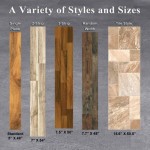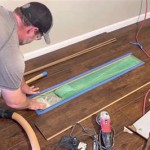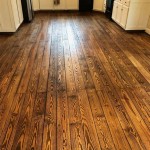Can You Put Vinyl Flooring On Concrete?
Vinyl flooring offers a combination of durability, affordability, and aesthetic appeal, making it a popular choice for homeowners and businesses alike. Concrete subfloors are common in many buildings, leading many to question the compatibility of these two materials. This article will explore the feasibility and considerations involved in installing vinyl flooring over concrete.
The short answer is yes, vinyl flooring can be installed over concrete. However, several factors must be considered to ensure a successful and long-lasting installation. Concrete, while durable, presents unique challenges as a subfloor. Its porous nature can lead to moisture issues, and its surface imperfections can affect the finished look and longevity of the vinyl flooring.
Moisture is a primary concern when installing any flooring over concrete. Concrete is naturally porous and can absorb moisture from the ground below. This moisture can migrate upwards, potentially damaging the vinyl flooring and promoting the growth of mold and mildew. Therefore, assessing the moisture content of the concrete slab is a critical first step.
Several methods exist for testing concrete moisture. Calcium chloride tests measure the amount of moisture vapor emitted from the concrete over a specific period. Relative humidity probes measure the moisture content within the concrete slab. Hygrometers assess the ambient humidity of the surrounding air. It's generally recommended to consult with a flooring professional to determine the most appropriate testing method and interpret the results.
If excessive moisture is detected, steps must be taken to mitigate the issue before installing vinyl flooring. Applying a moisture barrier or vapor retarder is a common solution. These products create a waterproof layer between the concrete and the flooring, preventing moisture from reaching the vinyl. Various types of moisture barriers are available, including epoxy coatings, sheet membranes, and liquid sealers.
Another important consideration is the condition of the concrete surface. Cracks, unevenness, and other imperfections can telegraph through the vinyl flooring, creating an unsightly and potentially unstable surface. Therefore, the concrete surface must be properly prepared before installation.
Minor cracks and imperfections can often be filled with a concrete patching compound. Larger cracks or significant unevenness may require more extensive repairs, such as grinding or leveling the concrete. A smooth, level surface is crucial for proper adhesion and a professional-looking finish.
Once the concrete subfloor is adequately prepared, the specific installation method will depend on the type of vinyl flooring chosen. Sheet vinyl, vinyl tile, and luxury vinyl planks (LVP) are common options, each with its own installation requirements.
Sheet vinyl is typically glued down to the concrete subfloor using a specialized adhesive. Vinyl tile can be installed using adhesive or a click-lock system. LVP, a popular choice for its realistic wood-look appearance, is often installed using a floating floor method, where the planks click together and are not directly attached to the subfloor. This method allows for some movement and expansion, making it less susceptible to moisture-related issues.
Underlayment may be used with certain types of vinyl flooring, particularly floating floors. Underlayment provides several benefits, including added cushioning, sound insulation, and a further barrier against moisture. Choosing the appropriate underlayment is essential, as some types are not compatible with all vinyl flooring products.
Acclimation is another crucial step in the installation process. Vinyl flooring should be allowed to acclimate to the room's temperature and humidity for a period specified by the manufacturer. This allows the material to expand or contract to its natural state before installation, minimizing the risk of warping or buckling after installation.
Proper installation is key to the longevity and performance of vinyl flooring. While some types of vinyl flooring are suitable for DIY installation, complex projects or situations involving moisture issues may require the expertise of a professional flooring installer. A professional can assess the subfloor, recommend appropriate solutions, and ensure a proper installation.
Choosing the right vinyl flooring for a concrete subfloor requires careful consideration of several factors. Moisture levels, subfloor condition, and the desired aesthetic all play a role in the decision-making process. By addressing these factors and following proper installation procedures, homeowners can enjoy the beauty and durability of vinyl flooring over a concrete subfloor for years to come.

How To Prepare A Concrete Floor For Vinyl Flooring Parrys

How To Install Vinyl Or Laminate Floors In A Basement Over Concrete Slab

Installing Luxury Vinyl Flooring On Concrete What You Need To Know 50floor

Tips For Installing Vinyl Plank Over Concrete Floors Lemon Thistle

How To Install Vinyl Flooring On Concrete Floor Ers

Concrete Subfloor Preparation For The Vinyl Floor Installation How To Diy Mryoucandoityourself

How To Install L And Stick Vinyl Tile On Concrete Floor Self Installation

How To Install Vinyl Plank Flooring On Concrete Whole Cabinet Supply

Things To Know About Vinyl Flooring Floor Supplier

Lvp Flooring Installation How To Install Luxury Vinyl Plank In A Basement Diy
See Also







